Showing Spotlights 1857 - 1864 of 2785 in category All (newest first):
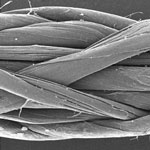 Few technologies on the near-term horizon offer as much potential for game-changing results as do carbon nanotube products. But in an age where the state-of-the-art in global defense, transportation and energy depend on meaningful advancement and delivery of novel materials, it is critical to view scalability to be as important as product performance itself. To date, few nanotechnology manufacturers have solved this scaling problem - choosing instead to focus most of their resources on research and advances in material science. Materials without a meaningful path to volume delivery will remain just that; novel inventions with very little practical value. Instead, addressing the issue of scaled production is the central challenge for today's nanotechnology firms.
Few technologies on the near-term horizon offer as much potential for game-changing results as do carbon nanotube products. But in an age where the state-of-the-art in global defense, transportation and energy depend on meaningful advancement and delivery of novel materials, it is critical to view scalability to be as important as product performance itself. To date, few nanotechnology manufacturers have solved this scaling problem - choosing instead to focus most of their resources on research and advances in material science. Materials without a meaningful path to volume delivery will remain just that; novel inventions with very little practical value. Instead, addressing the issue of scaled production is the central challenge for today's nanotechnology firms.
Apr 12th, 2010
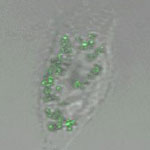 Silver nanoparticles can now be found in all kinds of products, from socks to food containers to coatings for medical devices. Valued for its infection-fighting, antimicrobial properties, silver, in its modern incarnation as silver nanoparticles, has become the promising antimicrobial material in a variety of applications because the nanoparticles can damage bacterial cells. Due to their plasmonic properties and easy surface chemistry silver nanoparticles are also beginning to attract interest among nanomedicine researchers. However, the surface chemistry of nanoparticles that governs their interactions with other constituents in their environment has critical importance. Therefore, chemically altering the surface properties of nanoparticles with polymers, biological ligands and macromolecules is actively being explored.
Silver nanoparticles can now be found in all kinds of products, from socks to food containers to coatings for medical devices. Valued for its infection-fighting, antimicrobial properties, silver, in its modern incarnation as silver nanoparticles, has become the promising antimicrobial material in a variety of applications because the nanoparticles can damage bacterial cells. Due to their plasmonic properties and easy surface chemistry silver nanoparticles are also beginning to attract interest among nanomedicine researchers. However, the surface chemistry of nanoparticles that governs their interactions with other constituents in their environment has critical importance. Therefore, chemically altering the surface properties of nanoparticles with polymers, biological ligands and macromolecules is actively being explored.
Apr 9th, 2010
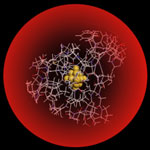 Nanotechnology can play an important role in water treatment and an active emerging area of research is the development of novel nanomaterials with increased affinity, capacity, and selectivity for heavy metals and other contaminants. The benefits from use of nanomaterials may derive from their enhanced reactivity, surface area and sequestration characteristics. In addition to heavy-metal ions such as mercury or lead, toxic anions like cyanide are of concern to environmental managers. Whereas toxic metals induce diseases by accumulating in the body, cyanide can directly cause death in as short a period as minutes by directly affecting the central nervous system. Researchers in China have now developed a relatively simple, cost-effective, environmentally friendly and yet highly sensitive cyanide sensor to test water samples.
Nanotechnology can play an important role in water treatment and an active emerging area of research is the development of novel nanomaterials with increased affinity, capacity, and selectivity for heavy metals and other contaminants. The benefits from use of nanomaterials may derive from their enhanced reactivity, surface area and sequestration characteristics. In addition to heavy-metal ions such as mercury or lead, toxic anions like cyanide are of concern to environmental managers. Whereas toxic metals induce diseases by accumulating in the body, cyanide can directly cause death in as short a period as minutes by directly affecting the central nervous system. Researchers in China have now developed a relatively simple, cost-effective, environmentally friendly and yet highly sensitive cyanide sensor to test water samples.
Apr 8th, 2010
 Silicon has dominated solid-state electronics for more than four decades but now a variety of other materials are being explored in photonic devices to expand the wavelength range of operation and to improve performance. Graphene is such a material - although most research on graphene so far has focused mainly on electronics. IBM researchers have now shown that graphene-based devices can be used in optical communications. Introducing this new material system into photonics could have a significant impact on mainstream optical applications. By using graphene, researchers make use of the internal electric field that exists at the interface of graphene and metal. Through a sophisticated combination of palladium and titanium electrodes they created a photodetector that does not rely on external current.
Silicon has dominated solid-state electronics for more than four decades but now a variety of other materials are being explored in photonic devices to expand the wavelength range of operation and to improve performance. Graphene is such a material - although most research on graphene so far has focused mainly on electronics. IBM researchers have now shown that graphene-based devices can be used in optical communications. Introducing this new material system into photonics could have a significant impact on mainstream optical applications. By using graphene, researchers make use of the internal electric field that exists at the interface of graphene and metal. Through a sophisticated combination of palladium and titanium electrodes they created a photodetector that does not rely on external current.
Apr 7th, 2010
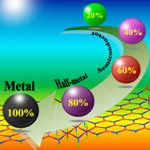 Researchers have been exploring boron nitride (BN) nanomaterials - from nanotubes to nanosheets and nanoribbons - and found similarities, but also differences to the the properties of the corresponding carbon nanomaterials. Motivated by the outstanding properties of graphene, the boron nitride single layer - a structural analogy of graphene - has been extensively studied both theoretically and experimentally, and has been experimentally realized. However, BN nanomaterials are wide-band-gap semiconductors, and their band structures are rather robust, and difficult to modulate, which is a substantial obstacle for their applications in nanoelectronic devices. Researchers have now shown that hydrogenation might be a simple approach to tune the band structure of graphene-like boron nitride structures.
Researchers have been exploring boron nitride (BN) nanomaterials - from nanotubes to nanosheets and nanoribbons - and found similarities, but also differences to the the properties of the corresponding carbon nanomaterials. Motivated by the outstanding properties of graphene, the boron nitride single layer - a structural analogy of graphene - has been extensively studied both theoretically and experimentally, and has been experimentally realized. However, BN nanomaterials are wide-band-gap semiconductors, and their band structures are rather robust, and difficult to modulate, which is a substantial obstacle for their applications in nanoelectronic devices. Researchers have now shown that hydrogenation might be a simple approach to tune the band structure of graphene-like boron nitride structures.
Apr 6th, 2010
 Taking the patent land grab to a new level, the government of Greece today, April 1, filed a patent and trademark application for the term nanotechnology with the European Patent Office. The country is thereby seeking the right to prevent third parties from commercially exploiting these and related terms without paying royalties. Notwithstanding the moral high ground the Greek government is trying to occupy, observers note that the real reason for this surprising move is very simple and very down-to-earth: money. Cash-strapped Greece, on the brink of bankruptcy, is desperate for revenues. Greece's massive debt problem has shaken the entire euro zone and undermined the shared currency. Greece's public debt is so high that the country could default - with potentially dire results for the Euro.
Taking the patent land grab to a new level, the government of Greece today, April 1, filed a patent and trademark application for the term nanotechnology with the European Patent Office. The country is thereby seeking the right to prevent third parties from commercially exploiting these and related terms without paying royalties. Notwithstanding the moral high ground the Greek government is trying to occupy, observers note that the real reason for this surprising move is very simple and very down-to-earth: money. Cash-strapped Greece, on the brink of bankruptcy, is desperate for revenues. Greece's massive debt problem has shaken the entire euro zone and undermined the shared currency. Greece's public debt is so high that the country could default - with potentially dire results for the Euro.
Apr 1st, 2010
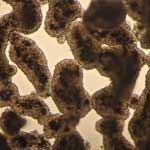 Mass culture of cell lines has long been fundamental to the manufacture of viral vaccines and many products of biotechnology. More recently it also has become an essential tool in stem cell research and tissue engineering. Most conventional petri dish based cell culture techniques produce monolayers cell growth that is missing essential cellular functions that are present in living organisms; gene expression, signaling and morphology can be different and this compromises its clinical relevance. It limits their potential to predict the cellular responses of real organisms. In order to develop cellular models that mimic the functions of living tissues, researchers have therefore been trying to move from two-dimensional to three-dimensional cultures. A recent example is a technique that uses magnetic levitation of cells in the presence of a hydrogel consisting of gold, magnetic iron oxide nanoparticles and filamentous bacteriophage. By spatially controlling the magnetic field while cells divide and grow, the geometry of the cell mass can be manipulated, and multicellular clustering of different cell types in co-culture can be achieved.
Mass culture of cell lines has long been fundamental to the manufacture of viral vaccines and many products of biotechnology. More recently it also has become an essential tool in stem cell research and tissue engineering. Most conventional petri dish based cell culture techniques produce monolayers cell growth that is missing essential cellular functions that are present in living organisms; gene expression, signaling and morphology can be different and this compromises its clinical relevance. It limits their potential to predict the cellular responses of real organisms. In order to develop cellular models that mimic the functions of living tissues, researchers have therefore been trying to move from two-dimensional to three-dimensional cultures. A recent example is a technique that uses magnetic levitation of cells in the presence of a hydrogel consisting of gold, magnetic iron oxide nanoparticles and filamentous bacteriophage. By spatially controlling the magnetic field while cells divide and grow, the geometry of the cell mass can be manipulated, and multicellular clustering of different cell types in co-culture can be achieved.
Mar 31st, 2010
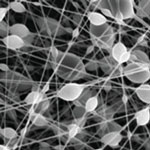 The concept of self-healing has become a popular theme in the field of material science. The whole concept of 'smart' materials that react on external impact - pH, humidity changes, or distortion of the coating integrity - and repair themselves has experienced a tremendous boost with the advent of nanotechnology. The nanoscale multilayer structure of a coating, in which the components are integrated and mutually reactive, is a main point in sophisticated and strong corrosion protection. Researchers have now proposed a new approach to self-healing polymer coating systems based on an electrospun coaxial healing agent. Electrospinning offers a number of unique opportunities. Most significantly, the location and concentration of the healing component can be spatially varied.
The concept of self-healing has become a popular theme in the field of material science. The whole concept of 'smart' materials that react on external impact - pH, humidity changes, or distortion of the coating integrity - and repair themselves has experienced a tremendous boost with the advent of nanotechnology. The nanoscale multilayer structure of a coating, in which the components are integrated and mutually reactive, is a main point in sophisticated and strong corrosion protection. Researchers have now proposed a new approach to self-healing polymer coating systems based on an electrospun coaxial healing agent. Electrospinning offers a number of unique opportunities. Most significantly, the location and concentration of the healing component can be spatially varied.
Mar 29th, 2010
 Few technologies on the near-term horizon offer as much potential for game-changing results as do carbon nanotube products. But in an age where the state-of-the-art in global defense, transportation and energy depend on meaningful advancement and delivery of novel materials, it is critical to view scalability to be as important as product performance itself. To date, few nanotechnology manufacturers have solved this scaling problem - choosing instead to focus most of their resources on research and advances in material science. Materials without a meaningful path to volume delivery will remain just that; novel inventions with very little practical value. Instead, addressing the issue of scaled production is the central challenge for today's nanotechnology firms.
Few technologies on the near-term horizon offer as much potential for game-changing results as do carbon nanotube products. But in an age where the state-of-the-art in global defense, transportation and energy depend on meaningful advancement and delivery of novel materials, it is critical to view scalability to be as important as product performance itself. To date, few nanotechnology manufacturers have solved this scaling problem - choosing instead to focus most of their resources on research and advances in material science. Materials without a meaningful path to volume delivery will remain just that; novel inventions with very little practical value. Instead, addressing the issue of scaled production is the central challenge for today's nanotechnology firms.
 Subscribe to our Nanotechnology Spotlight feed
Subscribe to our Nanotechnology Spotlight feed





